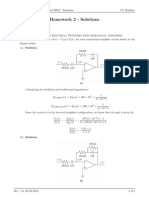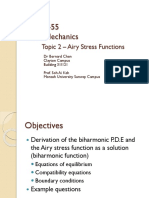Control Systems - Block Diagram
Uploaded by
Gilly Da BossControl Systems - Block Diagram
Uploaded by
Gilly Da BossMR.
AKETCH – A TVET TRAINER 07/09/2019
BLOCK DIAGRAMS
One way of modeling a physical system is by the use of block diagrams. A block diagram of a control
system is a simplified pictorial representation of various system components alternatively called system
elements. The block diagram is drawn to establish a mathematical relationship between the input, error
and output. A general block diagram consists of the individual blocks that represent the transfer function
of the individual elements.
Transfer function is defined as the ratio of the Laplace transform of the output variable from the system
to Laplace transform of the input signal causing that output, all initial conditions being zero.
Let the input-output behavior of a linear system or element of a system be given by the transfer function
G(s) =
[AKETCHECOBENZ] [TVET TRAINER] [KENYA COAST NATIONAL POLYTECHNIC]
General Block diagram of a feedback control system is given by
Fig. 3.6Closed loop control system block diagram. Also called canonical form of block
diagram
Where:
R(s) --- Reference input signal: It may take the forms sinusoidal, ramp, step,
parabolic etc.
E(s) ---Actuating (Error signal): This is derived from input reference signal and the
feedback signal.
G(s) ---The forward path gain
C(s) ---output signal or controlled variable
H(s) ---Feedback element used to detect measure the output
B(s)---Feedback signal
And the transfer function is given by
T(s) = =
Focusing on a negative feedback in this case;
[AKETCHECOBENZ] [TVET TRAINER] [KENYA COAST NATIONAL POLYTECHNIC]
From the canonical block diagram in fig.3.6 above, the following quantities can be derived;
i) Loop transfer function or open loop transfer function of a closed loop system
= G(s) H(s)
This derived below
= x
= H(s) G(s)
In many cases where |G(s) | >> 1, the closed loop transfer
Can be approximated by
This is called the approximate transfer function and is the inverse of feedback transfer function.
BLOCK DIAGRAM ALGEBRA
Example 2
Obtain using block diagram algebra the closed loop transfer function of the block diagram given below.
[AKETCHECOBENZ] [TVET TRAINER] [KENYA COAST NATIONAL POLYTECHNIC]
Solution
Example3
Use block diagram algebra to obtail the closed loop transfer fuction of the block diagram given below.
[AKETCHECOBENZ] [TVET TRAINER] [KENYA COAST NATIONAL POLYTECHNIC]
Solution
[AKETCHECOBENZ] [TVET TRAINER] [KENYA COAST NATIONAL POLYTECHNIC]
MULTIPLE INPUT SYSTEMS
Example 4
Use block diagram algebra to determine the relationship between input R, U and C
[AKETCHECOBENZ] [TVET TRAINER] [KENYA COAST NATIONAL POLYTECHNIC]
Example 5
Determine the relationship between the input R, U and the output from the system given below
[AKETCHECOBENZ] [TVET TRAINER] [KENYA COAST NATIONAL POLYTECHNIC]
Assignment
Use block diagram algebra to determine the transfer functions C(s)/R(s) for the block diagram given
below
NOTE: Transfer function of a block diagram can also be obtained by inspection i.e.
T(s) =
BLOCK REDUCTION TECHNIQUE
Bock diagrams of practical feedback control systems may be complicated due to the large number of
components used which form multiple loops with multiple inputs.
These block diagrams can be simplified for system studies by a systematic procedure known as block
diagram deduction.
Rules of block diagram reduction
[AKETCHECOBENZ] [TVET TRAINER] [KENYA COAST NATIONAL POLYTECHNIC]
[AKETCHECOBENZ] [TVET TRAINER] [KENYA COAST NATIONAL POLYTECHNIC]
To clearly understand these rules, we are going to go through a number of examples
[AKETCHECOBENZ] [TVET TRAINER] [KENYA COAST NATIONAL POLYTECHNIC]
[AKETCHECOBENZ] [TVET TRAINER] [KENYA COAST NATIONAL POLYTECHNIC]
[AKETCHECOBENZ] [TVET TRAINER] [KENYA COAST NATIONAL POLYTECHNIC]
[AKETCHECOBENZ] [TVET TRAINER] [KENYA COAST NATIONAL POLYTECHNIC]
[AKETCHECOBENZ] [TVET TRAINER] [KENYA COAST NATIONAL POLYTECHNIC]
[AKETCHECOBENZ] [TVET TRAINER] [KENYA COAST NATIONAL POLYTECHNIC]
[AKETCHECOBENZ] [TVET TRAINER] [KENYA COAST NATIONAL POLYTECHNIC]
[AKETCHECOBENZ] [TVET TRAINER] [KENYA COAST NATIONAL POLYTECHNIC]
[AKETCHECOBENZ] [TVET TRAINER] [KENYA COAST NATIONAL POLYTECHNIC]
[AKETCHECOBENZ] [TVET TRAINER] [KENYA COAST NATIONAL POLYTECHNIC]
[AKETCHECOBENZ] [TVET TRAINER] [KENYA COAST NATIONAL POLYTECHNIC]
[AKETCHECOBENZ] [TVET TRAINER] [KENYA COAST NATIONAL POLYTECHNIC]
[AKETCHECOBENZ] [TVET TRAINER] [KENYA COAST NATIONAL POLYTECHNIC]
[AKETCHECOBENZ] [TVET TRAINER] [KENYA COAST NATIONAL POLYTECHNIC]
[AKETCHECOBENZ] [TVET TRAINER] [KENYA COAST NATIONAL POLYTECHNIC]
[AKETCHECOBENZ] [TVET TRAINER] [KENYA COAST NATIONAL POLYTECHNIC]
[AKETCHECOBENZ] [TVET TRAINER] [KENYA COAST NATIONAL POLYTECHNIC]
[AKETCHECOBENZ] [TVET TRAINER] [KENYA COAST NATIONAL POLYTECHNIC]
[AKETCHECOBENZ] [TVET TRAINER] [KENYA COAST NATIONAL POLYTECHNIC]
[AKETCHECOBENZ] [TVET TRAINER] [KENYA COAST NATIONAL POLYTECHNIC]
You might also like
- Lecture 2-Block Diagram Reduction TechniquesNo ratings yetLecture 2-Block Diagram Reduction Techniques71 pages
- B - Lecture3 The Transfer Function and Block Diagram Automatic Control System100% (1)B - Lecture3 The Transfer Function and Block Diagram Automatic Control System21 pages
- Lecture 02 Electrical Networks Transfer FunctionNo ratings yetLecture 02 Electrical Networks Transfer Function18 pages
- Electrical Engineering Forenoon SessionNo ratings yetElectrical Engineering Forenoon Session29 pages
- CH 1 Number System and Numerical Error Analysis80% (5)CH 1 Number System and Numerical Error Analysis11 pages
- ECE 424FL - Feedback and Control Systems Laboratory - RevisedNo ratings yetECE 424FL - Feedback and Control Systems Laboratory - Revised7 pages
- Ps 0523 Power System Modelling and Analysis I: Symmetrical Fault Analysis Using Bus Impedance MatrixNo ratings yetPs 0523 Power System Modelling and Analysis I: Symmetrical Fault Analysis Using Bus Impedance Matrix62 pages
- ElectricCircuitsbyNoelM - morrisandFrankW.senior 1No ratings yetElectricCircuitsbyNoelM - morrisandFrankW.senior 1379 pages
- Automatic Control Systems: Transfer FunctionsNo ratings yetAutomatic Control Systems: Transfer Functions23 pages
- Questions On Electrical Machine Applications Armature Reaction and CommutationNo ratings yetQuestions On Electrical Machine Applications Armature Reaction and Commutation12 pages
- Feedback Control Systems (FCS) : Lecture-18 Steady State ErrorNo ratings yetFeedback Control Systems (FCS) : Lecture-18 Steady State Error23 pages
- Solicar Engineering Review Center and ServicesNo ratings yetSolicar Engineering Review Center and Services7 pages
- Chapter 2 Modeling in The Frequency Domain Skill-Assessment Exercise 2.5No ratings yetChapter 2 Modeling in The Frequency Domain Skill-Assessment Exercise 2.54 pages
- Circuit Theory - Solved Assignments - Semester Fall 2003No ratings yetCircuit Theory - Solved Assignments - Semester Fall 200335 pages
- "Three Phase Fault Analysis With Auto Reset ": Project ReportNo ratings yet"Three Phase Fault Analysis With Auto Reset ": Project Report55 pages
- Urdaneta City University College of Engineering and ArchitectureNo ratings yetUrdaneta City University College of Engineering and Architecture10 pages
- Eeeb113 Circuit Analysis 1: Chapter 6: Capacitors and Inductors Sharifah Azma Syed Mustaffa100% (1)Eeeb113 Circuit Analysis 1: Chapter 6: Capacitors and Inductors Sharifah Azma Syed Mustaffa25 pages
- Reviewer Electrical Circuits 1 Eea Exam 2No ratings yetReviewer Electrical Circuits 1 Eea Exam 217 pages
- Study, Analysis and Evaluation of Block Diagram Reduction Name: University of Polytechnic/college ofNo ratings yetStudy, Analysis and Evaluation of Block Diagram Reduction Name: University of Polytechnic/college of10 pages
- 351_27435_EE418_2016_1__2_1_0 3 Lec3 EE418 Block Diagram ReductionNo ratings yet351_27435_EE418_2016_1__2_1_0 3 Lec3 EE418 Block Diagram Reduction75 pages
- BTE3323-Control Systems-CHAPTER 3 - Block Diagrams and Signal Flow Graphs-Lecture 6-7No ratings yetBTE3323-Control Systems-CHAPTER 3 - Block Diagrams and Signal Flow Graphs-Lecture 6-773 pages
- Block Diagram Representation of Control SystemsNo ratings yetBlock Diagram Representation of Control Systems53 pages
- 351 - 27435 - EE417 - 2019 - 1 - 1 - 1 - 0 3 Lec3 EE418 Block Diagram ReductionNo ratings yet351 - 27435 - EE417 - 2019 - 1 - 1 - 1 - 0 3 Lec3 EE418 Block Diagram Reduction70 pages
- Theories and Applications of Plate Analysis 0471429899No ratings yetTheories and Applications of Plate Analysis 04714298994 pages
- G.D. Goenka Public School, Sector 22, Rohini Class - Ix Practice Sheet-2 Subjective PolynomialsNo ratings yetG.D. Goenka Public School, Sector 22, Rohini Class - Ix Practice Sheet-2 Subjective Polynomials2 pages
- 1 Functions, Limits and Continuity LagosNo ratings yet1 Functions, Limits and Continuity Lagos23 pages
- Inverse Trigonometric Functions: Key Concept InvolvedNo ratings yetInverse Trigonometric Functions: Key Concept Involved4 pages
- Artificial Intelligence Brief Course SummaryNo ratings yetArtificial Intelligence Brief Course Summary7 pages
- Back Analysis of Measured Displacements of Tunnels: TakeuchiNo ratings yetBack Analysis of Measured Displacements of Tunnels: Takeuchi8 pages
- ST2334 Notes (Probability and Statistics - NUS)No ratings yetST2334 Notes (Probability and Statistics - NUS)55 pages
- Namma Kalvi 10th Maths Book Back 1 Mark Questions With Answers em100% (1)Namma Kalvi 10th Maths Book Back 1 Mark Questions With Answers em11 pages
- 2.72 Elements of Mechanical Design: Mit OpencoursewareNo ratings yet2.72 Elements of Mechanical Design: Mit Opencourseware44 pages
- 12th Kips Objective Mathematics - Helping Book-Mdcat by Future Doctors - Touseef Ahmad-1No ratings yet12th Kips Objective Mathematics - Helping Book-Mdcat by Future Doctors - Touseef Ahmad-1124 pages
- Computation of Dominant Poles and Residue - IEEENo ratings yetComputation of Dominant Poles and Residue - IEEE12 pages
- u= x−x h v (v+1) ∇ y …+v (v+1) … v +n−1) n! ∇ y v= x−x h: Δ y y y i=0,1,2, …, n−1 ∇ y y y i=n, n−1, …, 1No ratings yetu= x−x h v (v+1) ∇ y …+v (v+1) … v +n−1) n! ∇ y v= x−x h: Δ y y y i=0,1,2, …, n−1 ∇ y y y i=n, n−1, …, 12 pages
- B - Lecture3 The Transfer Function and Block Diagram Automatic Control SystemB - Lecture3 The Transfer Function and Block Diagram Automatic Control System
- ECE 424FL - Feedback and Control Systems Laboratory - RevisedECE 424FL - Feedback and Control Systems Laboratory - Revised
- Ps 0523 Power System Modelling and Analysis I: Symmetrical Fault Analysis Using Bus Impedance MatrixPs 0523 Power System Modelling and Analysis I: Symmetrical Fault Analysis Using Bus Impedance Matrix
- ElectricCircuitsbyNoelM - morrisandFrankW.senior 1ElectricCircuitsbyNoelM - morrisandFrankW.senior 1
- Questions On Electrical Machine Applications Armature Reaction and CommutationQuestions On Electrical Machine Applications Armature Reaction and Commutation
- Feedback Control Systems (FCS) : Lecture-18 Steady State ErrorFeedback Control Systems (FCS) : Lecture-18 Steady State Error
- Chapter 2 Modeling in The Frequency Domain Skill-Assessment Exercise 2.5Chapter 2 Modeling in The Frequency Domain Skill-Assessment Exercise 2.5
- Circuit Theory - Solved Assignments - Semester Fall 2003Circuit Theory - Solved Assignments - Semester Fall 2003
- "Three Phase Fault Analysis With Auto Reset ": Project Report"Three Phase Fault Analysis With Auto Reset ": Project Report
- Urdaneta City University College of Engineering and ArchitectureUrdaneta City University College of Engineering and Architecture
- Eeeb113 Circuit Analysis 1: Chapter 6: Capacitors and Inductors Sharifah Azma Syed MustaffaEeeb113 Circuit Analysis 1: Chapter 6: Capacitors and Inductors Sharifah Azma Syed Mustaffa
- Study, Analysis and Evaluation of Block Diagram Reduction Name: University of Polytechnic/college ofStudy, Analysis and Evaluation of Block Diagram Reduction Name: University of Polytechnic/college of
- 351_27435_EE418_2016_1__2_1_0 3 Lec3 EE418 Block Diagram Reduction351_27435_EE418_2016_1__2_1_0 3 Lec3 EE418 Block Diagram Reduction
- BTE3323-Control Systems-CHAPTER 3 - Block Diagrams and Signal Flow Graphs-Lecture 6-7BTE3323-Control Systems-CHAPTER 3 - Block Diagrams and Signal Flow Graphs-Lecture 6-7
- 351 - 27435 - EE417 - 2019 - 1 - 1 - 1 - 0 3 Lec3 EE418 Block Diagram Reduction351 - 27435 - EE417 - 2019 - 1 - 1 - 1 - 0 3 Lec3 EE418 Block Diagram Reduction
- Theories and Applications of Plate Analysis 0471429899Theories and Applications of Plate Analysis 0471429899
- G.D. Goenka Public School, Sector 22, Rohini Class - Ix Practice Sheet-2 Subjective PolynomialsG.D. Goenka Public School, Sector 22, Rohini Class - Ix Practice Sheet-2 Subjective Polynomials
- Inverse Trigonometric Functions: Key Concept InvolvedInverse Trigonometric Functions: Key Concept Involved
- Back Analysis of Measured Displacements of Tunnels: TakeuchiBack Analysis of Measured Displacements of Tunnels: Takeuchi
- Namma Kalvi 10th Maths Book Back 1 Mark Questions With Answers emNamma Kalvi 10th Maths Book Back 1 Mark Questions With Answers em
- 2.72 Elements of Mechanical Design: Mit Opencourseware2.72 Elements of Mechanical Design: Mit Opencourseware
- 12th Kips Objective Mathematics - Helping Book-Mdcat by Future Doctors - Touseef Ahmad-112th Kips Objective Mathematics - Helping Book-Mdcat by Future Doctors - Touseef Ahmad-1
- u= x−x h v (v+1) ∇ y …+v (v+1) … v +n−1) n! ∇ y v= x−x h: Δ y y y i=0,1,2, …, n−1 ∇ y y y i=n, n−1, …, 1u= x−x h v (v+1) ∇ y …+v (v+1) … v +n−1) n! ∇ y v= x−x h: Δ y y y i=0,1,2, …, n−1 ∇ y y y i=n, n−1, …, 1

























































































